Giveaway and Q&A with Janneken Smucker, author of Amish Quilts: Crafting an American Icon
Janneken Smucker, author of the newly-released Amish Quilts: Crafting an American Icon, answers your quilt questions today.
 Janneken is Assistant Professor of History at West Chester University, consulting curator for the International Quilt Study Center & Museum at the University of Nebraska-Lincoln, and author of a number of publications on quilts and quilting.
Janneken is Assistant Professor of History at West Chester University, consulting curator for the International Quilt Study Center & Museum at the University of Nebraska-Lincoln, and author of a number of publications on quilts and quilting.
Johns Hopkins University Press is giving away a copy of Amish Quilts. If you submitted a question for Janneken, you are already entered to win.
You can also get another entry to the contest by leaving a comment on this post. We’ll announce the winner on Monday.
You asked some good questions of Janneken. I think you’ll find her answers interesting, and some of them unexpected. If you enjoy what you read here, I think you’ll enjoy her book.
Thank you Janneken, for helping us learn more about Amish quilts.
Janneken Smucker on Amish Quilts
Pat, Alice Mary, and Karen Pollard: Is it true that the Amish purposely put a mistake in each quilt? I have heard they do this because only God is perfect and so they make sure they never make a perfect quilt.
This is a great example of the folklore carried with quilts. I heard someone recount asking an Amish quiltmaker herself this very question, and she replied, “I do not need to remind God how imperfect I am.”
Interestingly, dealers in Oriental carpets and Navajo blankets use this same “justification” for errors and inconsistencies in the works they sell, suggesting that it may be the business of selling objects that has perpetuated ideas such as this. As a quiltmaker, I can say that I do not intend for the quilts I make to have mistakes, but they always do.
Quilts for home vs. quilts for sale.
Several of you asked about various aspects of the differences between quilts made to sell and quilts made for home use. This is a hard question to answer because there is a) great diversity among quilts made for sale, and b) great diversity among Amish preferences, both at the individual and community level.
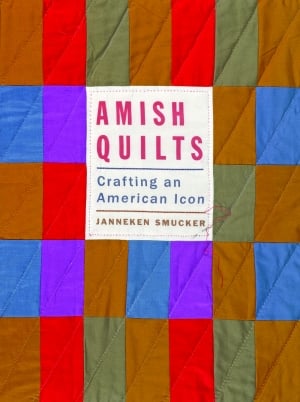 Walk into an Amish quilt shop in Lancaster County today and you will likely see a great array of patterns, colors, styles, and tastes. As one Amish woman said, “We try to do all kinds of quilts.” Similarly, Amish taste varies widely. As Barb notes, some families have long preferred store bought comforters or chenille bedspreads instead of quilts. Some Amish who do use quilts on their own beds might choose solid colors in simple geometric pieced patterns (that’s definitely true among more conservative groups like the Nebraska or Swartzendruber groups) while others have adopted styles like those sold in Amish quilt shops, featuring cheery applique, printed fabrics, and a wide variety of colors.
Walk into an Amish quilt shop in Lancaster County today and you will likely see a great array of patterns, colors, styles, and tastes. As one Amish woman said, “We try to do all kinds of quilts.” Similarly, Amish taste varies widely. As Barb notes, some families have long preferred store bought comforters or chenille bedspreads instead of quilts. Some Amish who do use quilts on their own beds might choose solid colors in simple geometric pieced patterns (that’s definitely true among more conservative groups like the Nebraska or Swartzendruber groups) while others have adopted styles like those sold in Amish quilt shops, featuring cheery applique, printed fabrics, and a wide variety of colors.
Terry Berger: Are more Amish men involved in quilting than before?
Since quiltmaking has become a common business within many Amish settlements, men have indeed become more involved. Sometimes men—particularly those who have retired from farming or other occupations—help with the production process by cutting fabric or marking quilting designs. But more common from my observations are men who help run the businesses, sometimes handling the retail side of things while their wives coordinate the design and production of quilts.
Amy Hering and MaryAnn Pepe: I am also wondering if most Amish sew by hand, on a treadle machine, or one with improvised power. Do the Amish ever use any machinery (without electricity, of course) while making quilts?
Many of the earliest identified Amish quilts, made in the 1870s and 1880s, feature machine stitching. To farmwives such as Amish women, the sewing machine was a great timesaving device for sewing clothing and quilts. Once sewing machines were electrified, Amish women continued to use treadle versions. Today, Amish women working in the quiltmaking industry or sewing at home use contemporary sewing machines retrofitted to run on alternative energy sources, like hydraulic pumps or compressed air, or the old-fashioned treadle. While they use machines to piece quilts, Amish women continue to quilt by hand.
Slightly-Handled-Order-Man: Will a quilt stay within a family and be passed down from generation to generation?
Many of us associate quilts with warmth, comfort, and home. Quilts are frequent gifts, passed down from one generation to another. This has been common within many Amish communities as well. Many mothers made, or hired someone else to make, a quilt to send with their offspring when they left home, and these quilts were often reserved for guest beds or for display on beds when hosting church. Families did treat these quilts as treasured heirlooms, passing them on from generation to generation or selling them at private “family sales.”
But that changed when outsiders became interested in old Amish quilts in the early 1970s. As prices began to rise for “old dark quilts” families were quicker to sell. Part of this was because quilts had become a liability; rather than risk a break-in or lose a highly valued quilt in a house fire, families sold. And further, once the outside world valued quilts as status symbols, many Amish families perceived that they no longer seemed appropriate objects to keep within their homes.
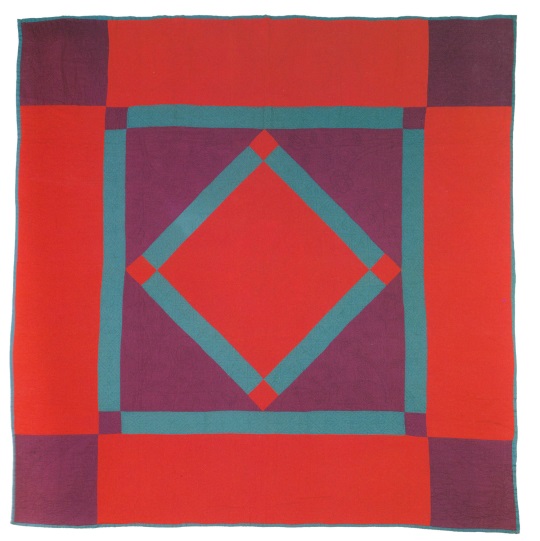
Mary Yoder: Do the Amish still make Friendship Quilts and what are they?
Mary, I’d love if you could answer the question regarding whether Amish still make friendship quilts. As a historian, I’ll comment on the past practice. American quiltmakers have made friendship quilts since at least the 1840s, when it became a fad among elite social networks in mid-Atlantic cities. The first Amish-made friendship quilt I have identified is dated 1899 and attributed to a group of Topeka, Indiana, Amish quiltmakers. Along with names, it features messages including “Remember Me,” and “Forget Me Not,” sentiments also common on non-Amish friendship quilts of the 19th century.
Particularly among Midwestern Amish settlements, friendship quilts were a popular way to tie friends and relatives together, often scattered across states. Prior to Lewis Harshberger’s 21st birthday, his mother, Cora Etta, sent templates to his friends, collecting enough spool-shaped fabric pieces signed in embroidery stitches to fill not one, but two quilts. By the 1950s, some Amish individuals stitched not only their names, but even their mailing addresses into friendship quilts, creating a fabric address book.
Mary, how does the tradition continue today?
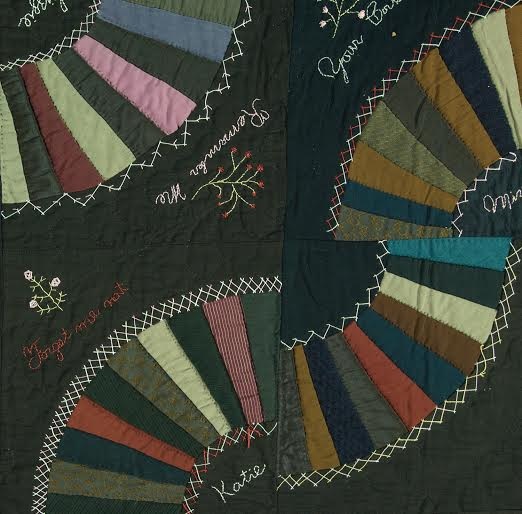
Marilyn: Do the Amish put some kind of markings or date to identify the one who made the quilt?
In terms of historical Amish quilts, we’re lucky to discover quilts with dates or attribution. In my research, I’ve identified around 300 quilts that are in museums or private collections with dates stitched into them, ranging from 1864 to 1963. Amish makers did not tend to sign their names like an artist signs a painting. But in some settlements—particularly in Indiana and Ohio—makers commonly embroidered or quilted the recipient’s name on a gifted quilt and sometimes the date of creation.
Among quilts Amish have made for the commercial market in recent years, the practice of signing quilts varies from shop to shop. Many consumers like to own a signed quilt, as it serves as a seal of authenticity, even thought typically a number of Amish women—rather than just one—contributes to a quilt. Some Amish quilt entrepreneurs are happy to oblige and sign quilts with the proprietor’s name.
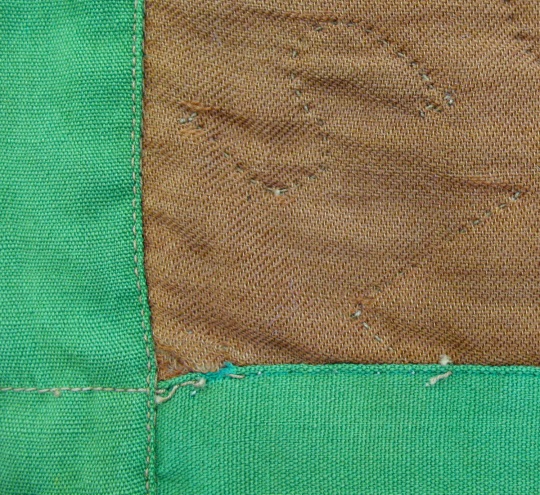
Sharon C: What makes an Amish quilter better than an English quilter?
Some Amish women are fantastic quilters. Some hate to quilt and are not good at it. The same can be said for the non-Amish. Yet why have consumers and collectors perceived Amish quilts as better? To answer this question, we must examine first, the time period in which outsiders “discovered” Amish quilts and second, the contemporary consumer market for quilts.
In the late 1960s and early 1970s, New York art enthusiasts in close proximity to Lancaster’s Amish settlement thought that old Amish quilts from this community looked like abstract paintings and began buying them to hang on the wall. Certain Amish quilts, like Center Diamond and Bars, looked distinctly different than ones that non-Amish made. These art enthusiasts liked the graphic simplicity of these patterns, typically pieced in solid-colored fabrics. To collectors familiar with modern art, Amish quilts were better aesthetically than non-Amish ones. They looked good in modern settings, like loft apartments and stark white galleries.
These old quilts helped establish a reputation for new-made quilts Amish entrepreneurs began making to sell to tourists. Due to the high price collectors paid for quilts as art objects, Americans began to associate Amish-made quilts with high quality workmanship. Yet, some of these consumers instead wanted a quilt that would match the “country” style décor favored by many in the 1980s. Consumers brought in curtain and rug swatches to commission quilts to match their bedrooms. And the resulting quilts typically were of high quality with fine hand quilting.
“Amish,” in turn, became a sort of brand consumers could trust, and were willing to pay a premium for. One consumer in Lancaster County begged the shop owner in the mid-1980s, saying, “Please tell me an Amish woman made this quilt.”
In short, consumers liked the idea of “Amish-made,” assuming it must be better, because of mainstream culture’s association of the Amish with hard work, simplicity, and fine craftsmanship.
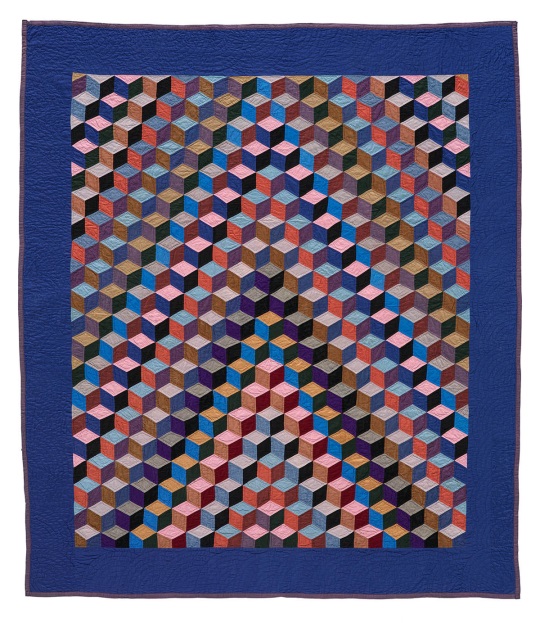
Lanore Lewis: Why are Amish quilts so expensive?
Again, I can address this question in terms of antique Amish quilts and ones made more recently for the consumer market.
Old Amish quilts of a certain style—the ones pieced from solid-colored fabrics in simple geometric designs—became expensive when outsiders began to perceive them as art objects, status symbols worth displaying in one’s home or collecting to hang in galleries. There were only a finite number of these old quilts, and when demand was high in the 1970s and 80s, prices skyrocketed. I’ve tracked the price of old Amish quilts sold at public auction. These prices topped out around $17,000, although quilts have sold privately for no doubt more than this.
New Amish quilts are actually relatively inexpensive if you consider the amount of labor and materials involved in their creation. As Karen Pollard noted in the comments earlier this week, the fabric, batting, and thread make up a significant (and rising) expense. And then there’s the labor.
Usually Amish women charge for quilting (the hand stitches that holds the three layers of a quilt together) by the yard of thread. In the early 1980s, the going rate was around 25 or 30 cents a yard, which based on the amount of stitches I estimate in a queen-size quilt, resulted in $75 to $135, or $.63 to $1.13 an hour.
By the mid-2000s, this rate had increased to around $2.00 an hour, still far from the minimum wage. If quilters earned a living wage, the price businesses charge for Amish quilts would be much higher.


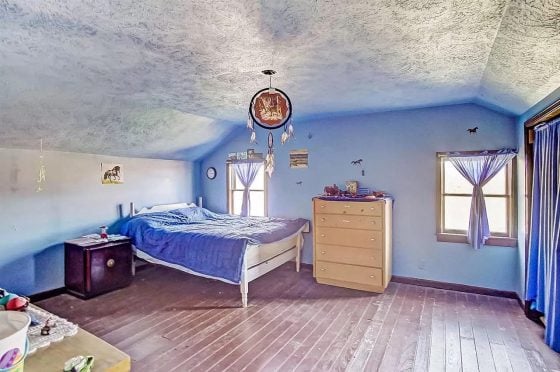
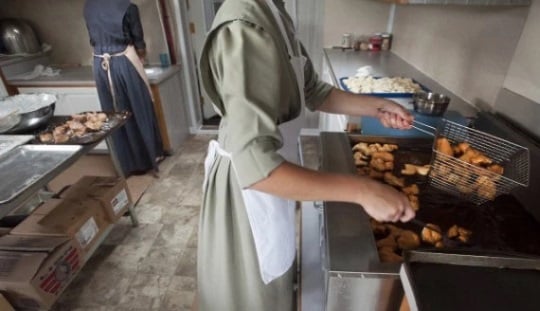

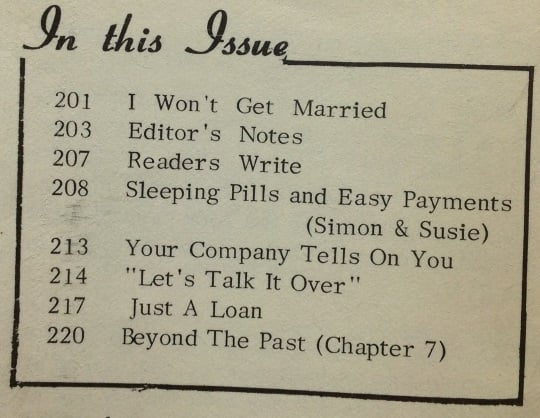

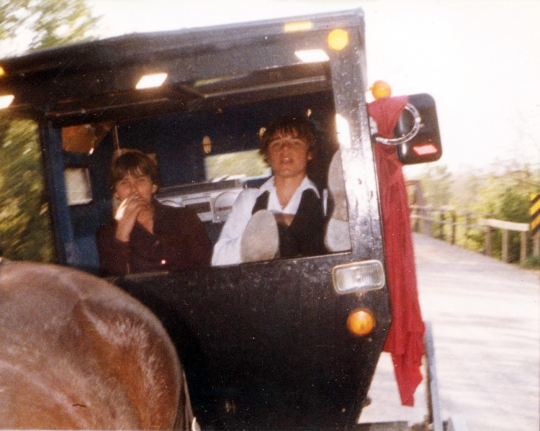
Amish Quilting Mistakes
I am so glad you addressed this mystery. I have long heard the Amish intentionally make a mistake and just could not accept that as truth. The Amish quality of workmanship and pride in their work is one of the very trademarks of their culture. Being a quilter, I could not imagine a quilt-maker intentionally making a mistake. It really upsets me to find a mistake I made after the quilt is complete and can no longer be corrected.
Thank you for this article. It was most informative.
Mistakes on Purpose!
I, too, am glad you answered the question I (and others) posed about intentional mistakes. I do know how frustrating it is to find a mistake when it is too late to be corrected, so I know I’d not be able to do intentional mistakes when quilting! All the questions and answers were very interesting. Thank you for sharing your expertise!
Fabulous!
This is SO fascinating. I travel to Amish Country several times a year and always admire the intricate handiwork of their quilts. I would treasure this book as a valued part of my collection. It looks and sounds fantastic.
Thank you so much for answering our questions. I learned a lot from reading your replies. I am trying to save up so I can go to an Amish ladies house, near here, and buy one of her beautiful quilts for myself.
Interesting
Thanks for the interesting article on Amish quilts.
I enjoyed reading these questions and answers. I’ve been wondering some of the same things myself.
Amish Quilts
Thanks for the interesting article on Amish quilts. Should be a great book.
Thank you so much! I look forward to reading your book.
Also, someday I hope to own an Amish-made quilt!
If I don’t win this book, I will be buying it! I love the info, and appreciate the opportunity to win. Thanks!!!
Interesting post! I find there’s something almost magical about quilts, that’s why I’m always drawn to stories that include quilts. And there quite a few around.
Thanks
Janneken, thanks for sharing so much of the fruit of your research with us. I look forward to reading your book!
Thank you, Janneken, for sharing your findings and examples. And especially for attempting to eliminate the purposeful mistake myth.
delightful book
Thanks for the opportunity to “win” a copy of this book! If I win, it will be a gift to a dear friend of mine, Katy, who is an elderly Amish quilter. Sara
Use of color
I find it quite interesting how the Amish are “plain” and quite basic in their choices of color for their clothing, etc. However, their color choices for their quilts are often quite vibrant, bold… Is there a particular reason for this?
Use of Color
Over the last hundred plus years, Amish have used a wide range of colors in their clothing, with preferred hues changing based on prevailing community standards. In the early twentieth century, Amish quiltmakers typically used the same sorts of fabric they used to make clothing, and this often included bright shades more commonly worn by children. The local “Ordnung” provided some guidance for clothing choices, but to my knowledge usually did not dictate quiltmaking styles, which might suggest that this was fertile ground for experimentation.
I appreciate your insights. Thank you. We live near the Arthur, Illinois area. Predominant color choices for clothing seem to be: light blue, navy blue, emerald green, purple, maroon, and of course black. However, many area quilts include these colors as well as much more vibrant ones. I do find it interesting, and it probably is an exceptional way for them to explore their more creative sides. I honestly don’t think I’ve ever seen an Amish quilt that I didn’t appreciate; however, some of them are just “drop dead gorgeous”!
thank you
Thanks so much for separating fact from fiction! I have learned so much about quilts from this column. My grandmother was a quilter and made many quilts over her lifetime. Sadly, after she died, quilts became desired objects and her son sold them off so family members did not receive any. Look forward to learning more. My desire one day is to own a pieced, hand stitched quilt. Again, thank you for taking the time to write and taking the time to write your book. I would live to own a copy one day.
Tina
comment on Giveaway with Jannekan Smucker
Many of our friends know we visit many of the Amish communities therefore they think we know many of the answers to their questions concerning the Amish.
Now, I have more accurate info concerning quilt making thanks to Janneken Smucker’s Q & A collumn.
Thank you. I learned so much from it.
I cant wait to read your book!! While Im not an expert quilter at all, I’ve helped put quite a few together years ago. Someday, I’ll pick it up again and I’d love to read your book so I can use old time Plain patterns. Thanks so much!
Amish Quilts
I will add this book to my must read list. I love looking at Amish quilts. I was in a quilt store in Sugarcreek, OH over the summer and the quilts were beautiful. I especially like the folded star pattern.
Thank you for the informative Q & A. I’m a little late with this question but have you heard of the Hmong sending quilts to auctions? I’ve started to see it regularly in Wisconsin Amish auctions for the last few years. Also, when they are up for auction there is no mention that said quilt is Hmong or Amish quilted. Your thoughts, Janneken?
whenever we go to the Amish Country in Ohio, I always stop by as many shops that I can, to admire the Amish handmade quilts, but even better is to drive by a farm, and see quilts blowing in the wind, as they hang from their clotheslines!!! ! Would love to win your book! Thank you for a wonderful give away!
At what age do the Amish ladies start quilting? Do they go to the quilting sessions or do they make their own with all the new mistakes while learning. Thank you for the chance to win your book.
Very informative article, I would love to win your book. I have recently started dabbling in quilting but am not up to full sized quilts, just small practice pieces so far.
Quilts
You certainly answered a lot of the questions I had about Amish Quilts. I still would love to have a homemade Amish Quilt. Maybe some day in the future.
I am in awe of Amish Quilts
It is my dearest wish to someday have a beautiful Amish quilt. Thank you for your blog post today!
Debbie Rhoades
ReadingMama922@gmail.com
Both of my Amish grandmothers pieced lots of quilts. As a child I KNEW that someday I would also piece lots of quilts. When is someday? (I have pieced several, but not like I was “planning”.)
Amish grandmothers
Mary,
It is never too late. I retired from teaching six years ago and nearly lost my mind from boredom. When a friend suggested I take quilting lessons with her, I went just to have something to do. I despise sewing!!!
Oh my gosh! Did I ever get addicted to quilting. I didn’t start until I was 60, so there’s always time to get going, girlfriend!!!
Some questions went unanswered...
…including mine. Will a second session of responses be posted?
Thank you, Janneken, for your answers. I truly doubted the “purposeful mistakes”—and I’ve heard this attributed to furniture as well as quilts. As I said, it seems too prideful to be anything the Amish would consider doing!
The more I read (your answers), the more fascinating the book becomes!
Alice Mary
WOULD LOVE TO WIN.
thank you
The more I read about the Amish, the more I admire them. Thank you for this work!
Amish Quilts
I enjoy quilting and would love to win a copy of this book.
Thank you for the opportunity !
Giveaway and Q&A with Janneken Smucker
Great answers to many questions, we all had! Thank you! I so hope I can win your book; if not, then I’ll surely go buy it. I love going to quilt shows, and am in ‘awe’ of them all! I just wonder, HOW do they get all of these designs to ‘work’ together?!
I have only quilted ONE pillow top (patchwork design), and I have plenty of scraps that my friend gave me, so I’m ready to start a “real quilt”, this time…I really need some instruction, since I’ve never done this before! I have sewn before, and used to make my own clothes, but since then, have sold my sewing machine, so mine will be done by hand….might take a lot of years, for me to finish it, but I’ll give it a try!!
SharonR
Nice Opportunity
What a nice opportunity to win what appears to be an outstanding boo!
Nice Opportunity
What a nice opportunity to win what appears to be an outstanding book!
wonderful person
In reading your comments, it shows how wonderful a person you are and how much you have investigated this subject. Thank you for this opportunity for interaction.
Amish Quilts
I have read several books about Amish quilts having a small flaw in them. As was mentioned, they do it to show they are not perfect only God is perfect. A quilt is never supposed to be perfect, but sewn with love and care and design.
Quilts are not cheap to make. I make my own and give some as gifts and material and all is very expensive. Depending on the size of the quilt, it can take several months, to years to make a quilt. Also depends on the design on it. The price that the Amish charge for their quilts is very reasonable! PA is over priced for the quilts, but the ones in Iowa and MN. are very reasonably priced, in fact almost cheap when you add up the labor, cost of materials, and all the people that help with the quilt.
appreciation
This was so insightful. I machine piece but love Hand quilting. The joy that comes from gifting them inspires me to do more. I can see why the older ones are so valued. I love reading about the Amish life. It brings the value of simplicity to my work. I am just a beginner but the family all anxiously wait for their personalized quilt. I did wonder whether the Amish embroider and to what extent.
Quilts
I love Amish quilts and have wanted to buy one every time I have seen them but couldn’t afford them even in Minnesota in the Lanesboro area. I love how the men are taking part in this. I too, am a historian, but a different kind, a genealogist and often work on Mennonite research. Would love to win. The winner will be so lucky!
I would love to win a copy of this book and thank you very much for the opportunity.
Janneken Smucker has an interesting way of writing details, without highfalutin words. Back in the 1900s, I was given a quilt block for me to embroider my name on. Finally, everyone else except me had finished their block for the friendship quilt, so they said they would go ahead and make the quilt without my square, and mine could be used for a pillow. Sometimes friendship quilts are given to a retiring teacher, with the students’ names.
In Mississippi, 97 Mennonite women came together to make quilts and comforters. Magnolia’s Guest Day Sewing, by Julia Graber, with 9 photos.
http://juliagraber.blogspot.com/2013/11/magnolias-guest-day-sewing.html?spref=fb
I came across an Amish Indiana Friendship Vintage Quilt, Helmuth Family 1932, from the Nappanee area. If I read it correctly, it is for sale for $1,575.00!
http://www.laurafisherquilts.com/shop/Quilts/SPECIALTY-QUILTS/SignatureFriendshipAlbum-Quilts/p/AMISH-INDIANA-FRIENDSHIP-VINTAGE-QUILT-HELMUTH-FAMILY-1932-sku-10329.htm
Thank you for your informative article. My question: What is the most meaningful “surprise” you found in your research?